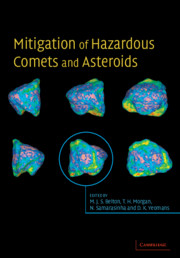Book contents
- Frontmatter
- Contents
- List of contributors
- Preface
- Acknowledgments
- Glossary
- 1 Recent progress in interpreting the nature of the near-Earth object population
- 2 Earth impactors: orbital characteristics and warning times
- 3 The role of radar in predicting and preventing asteroid and comet collisions with Earth
- 4 Interior structures for asteroids and cometary nuclei
- 5 What we know and don't know about surfaces of potentially hazardous small bodies
- 6 About deflecting asteroids and comets
- 7 Scientific requirements for understanding the near-Earth asteroid population
- 8 Physical properties of comets and asteroids inferred from fireball observations
- 9 Mitigation technologies and their requirements
- 10 Peering inside near-Earth objects with radio tomography
- 11 Seismological investigation of asteroid and comet interiors
- 12 Lander and penetrator science for near-Earth object mitigation studies
- 13 Optimal interception and deflection of Earth-approaching asteroids using low-thrust electric propulsion
- 14 Close proximity operations at small bodies: orbiting, hovering, and hopping
- 15 Mission operations in low-gravity regolith and dust
- 16 Impacts and the public: communicating the nature of the impact hazard
- 17 Towards a national program to remove the threat of hazardous NEOs
- Index
11 - Seismological investigation of asteroid and comet interiors
Published online by Cambridge University Press: 12 October 2009
- Frontmatter
- Contents
- List of contributors
- Preface
- Acknowledgments
- Glossary
- 1 Recent progress in interpreting the nature of the near-Earth object population
- 2 Earth impactors: orbital characteristics and warning times
- 3 The role of radar in predicting and preventing asteroid and comet collisions with Earth
- 4 Interior structures for asteroids and cometary nuclei
- 5 What we know and don't know about surfaces of potentially hazardous small bodies
- 6 About deflecting asteroids and comets
- 7 Scientific requirements for understanding the near-Earth asteroid population
- 8 Physical properties of comets and asteroids inferred from fireball observations
- 9 Mitigation technologies and their requirements
- 10 Peering inside near-Earth objects with radio tomography
- 11 Seismological investigation of asteroid and comet interiors
- 12 Lander and penetrator science for near-Earth object mitigation studies
- 13 Optimal interception and deflection of Earth-approaching asteroids using low-thrust electric propulsion
- 14 Close proximity operations at small bodies: orbiting, hovering, and hopping
- 15 Mission operations in low-gravity regolith and dust
- 16 Impacts and the public: communicating the nature of the impact hazard
- 17 Towards a national program to remove the threat of hazardous NEOs
- Index
Summary
Overview
Understanding the interior structure and composition of asteroids and comets is important for understanding their origin and evolution. In addition to basic science objectives, understanding the interior structure of near-Earth objects (NEOs) will be essential to addressing mitigation techniques should it become apparent that such an object has the potential to impact Earth. NEOs are comprised of asteroids and comets in near-Earth space. Work is progressing to find, catalog, and determine the orbits of NEOs larger than 1 km, but little is known about NEOs' bulk properties, such as strength and structure (Huebner et al. 2001; Greenberg and Huebner 2002). Should a Potentially Hazardous Object (PHO) threaten Earth, attention would focus on countermeasures. All conceived countermeasures rely on knowledge of the bulk material properties of NEOs, in particular material strength, structure, mass distribution, and density. It is believed that NEO compositions range from nickel–iron through stony and carbonaceous to ice-and-dust mixtures. Their structure can be monolithic, fractured, assemblages of fragmented rock held together only by self-gravity (“rubble piles”), porous, or fluffy. Types of collision mitigation and countermeasures will vary widely depending on composition and structure.
Much of the lack of knowledge of the interior properties of NEOs is due to the fact that most study has been by remote sensing. Information such as rotation rate and shape can be determined remotely through radar and light curve analysis, but determining the geophysical and geological properties requires something more. Two techniques of imaging the interior are apparent: radio tomography (electromagnetic waves) and seismology (mechanical waves).
- Type
- Chapter
- Information
- Mitigation of Hazardous Comets and Asteroids , pp. 234 - 265Publisher: Cambridge University PressPrint publication year: 2004
- 3
- Cited by

